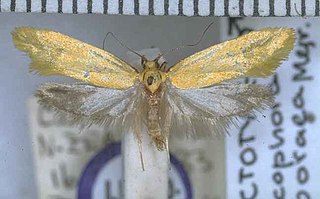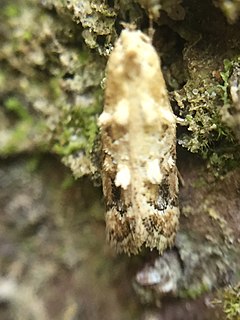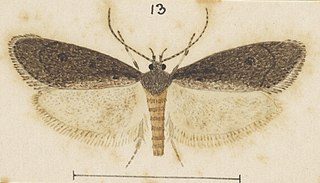
Asaphodes is a genus of moths in the family Geometridae erected by Edward Meyrick in 1885. This genus is endemic to New Zealand and species within this genus are found throughout New Zealand including the North, South and Stewart / Rakiura Islands.

Asaphodes chionogramma is a moth in the family Geometridae. It is endemic to New Zealand and found in both the North and South Islands. This species inhabits the lower slopes of mountains in valleys with native forest at altitudes of between 2000 and 3000 ft. The adults of this species are on the wing in December and January.

Asaphodes chlamydota is a moth in the family Geometridae. It is endemic to New Zealand, and can be found in the lower part of the North Island and in the South Island. It inhabits native forest and shrublands. The larvae of this species feeds on native Clematis plants including Clematis afoliata. Adults are on the wing from November to April and are regarded as having intermedia flight powers.

Xanthorhoe orophyla is a moth of the family Geometridae. It is endemic to New Zealand.

Tingena is a genus of the concealer moth family (Oecophoridae). This genus is endemic to New Zealand.

Tingena anaema is a species of moth in the family Oecophoridae. It is endemic to New Zealand and has been collected at Lake Wakatipu, Invercargill and Stewart Island / Rakiura. The adults of the species are on the wing in December.

Tingena aphrontis is a species of moth in the family Oecophoridae. It is endemic to New Zealand and has been collected at altitudes between 3000 - 5000 ft at Arthur's Pass and Mount Arthur. The species lives in open alpine habitat amongst alpine vegetation. Adults of the species are on the wing in January.

Tingena chloritis is a species of moth in the family Oecophoridae. It is endemic to New Zealand and has been found in the South Island. Larvae of this species feed on leaf litter. The adults of this species are light flyers and are attracted to light.

Tingena homodoxa is a species of moth in the family Oecophoridae. It is endemic to New Zealand and is found in the southern parts of the South Island. It inhabits open grassy slopes and is on the wing from November until January.

Tingena letharga is a species of moth in the family Oecophoridae. It is endemic to New Zealand and has been observed in Otago. Adults are on the wing in December and January.

Tingena oporaea is a species of moth in the family Oecophoridae. It is endemic to New Zealand and has been observed in Canterbury. The perferred habitat of this species is native beech forest at altitudes of 2500 ft however it has also been collected in tussock grassland. The larvae of this species are leaf litter feeders and the adults are on the wing in January and February.

Tingena siderodeta is a species of moth in the family Oecophoridae. It is endemic to New Zealand and is found throughout the country. This species prefers to inhabit native forest and scrubland but has also been found to be common in cultivated landscapes. The larvae are litter feeders and have been observed in Kanuka and Manuka forest. The adult moths are on the wing from October to February and are day flying but have also been trapped at night.

Asaphodes nephelias is a moth in the family Geometridae. It is endemic to New Zealand and has been observed in the South Island. The preferred habitat of this species is alpine tussock grasslands above native forest and in wetlands. The adults of this species are on the wing from January to March and are day flying. The female has brachypterous wings.

Trachypepla aspidephora is a species of moth in the family Oecophoridae. It is endemic to New Zealand and has been observed in the North and South Islands. Adults are on the wing from November to March and are attracted to light. The moths can be found resting on tree trunks where their colouration imitates lichens.

Atomotricha ommatias is a moth in the family Oecophoridae first described by Edward Meyrick in 1883. It is endemic to New Zealand.

Barea exarcha is a moth of the family Oecophoridae. This species was first described by Edward Meyrick in 1883. It is found in Australia and New Zealand.

Trachypepla leucoplanetis is a moth of the family Oecophoridae first described by Edward Meyrick in 1883. It is endemic to New Zealand and has been collected in both the North and South Islands. It is the smallest moth species in the genus Trachypepla and the patterns on the forewings of adults are variable in appearance. It inhabits native forest and bush and the larvae feed on leaf litter. Adults are on the wing from October until February. T. leucoplanetis is regarded as being rarely observed and has been collected via the beating of foliage.

Trachypepla lichenodes is a moth of the family Oecophoridae first described by Edward Meyrick in 1883. It is endemic to New Zealand and has been found in both the North and South Islands. It inhabits native forest and adults of this species are on the wing from November to January. The adult moths are similarly coloured to native lichen species however this colouration is variable in the extent and depth on the forewings.

Trachypepla photinella is a moth of the family Oecophoridae first described by Edward Meyrick in 1883. It is endemic to New Zealand and has been collected in Wellington, Wainuiomata, D'Urville Island and Christchurch. The preferred habitat of this species is native forest and adults are on the wing from December until February.

Trachypepla is a genus of moths of the family Oecophoridae. It was circumscribed in 1883 by Edward Meyrick. The species within this genus are indigenous to Australia and New Zealand.




















